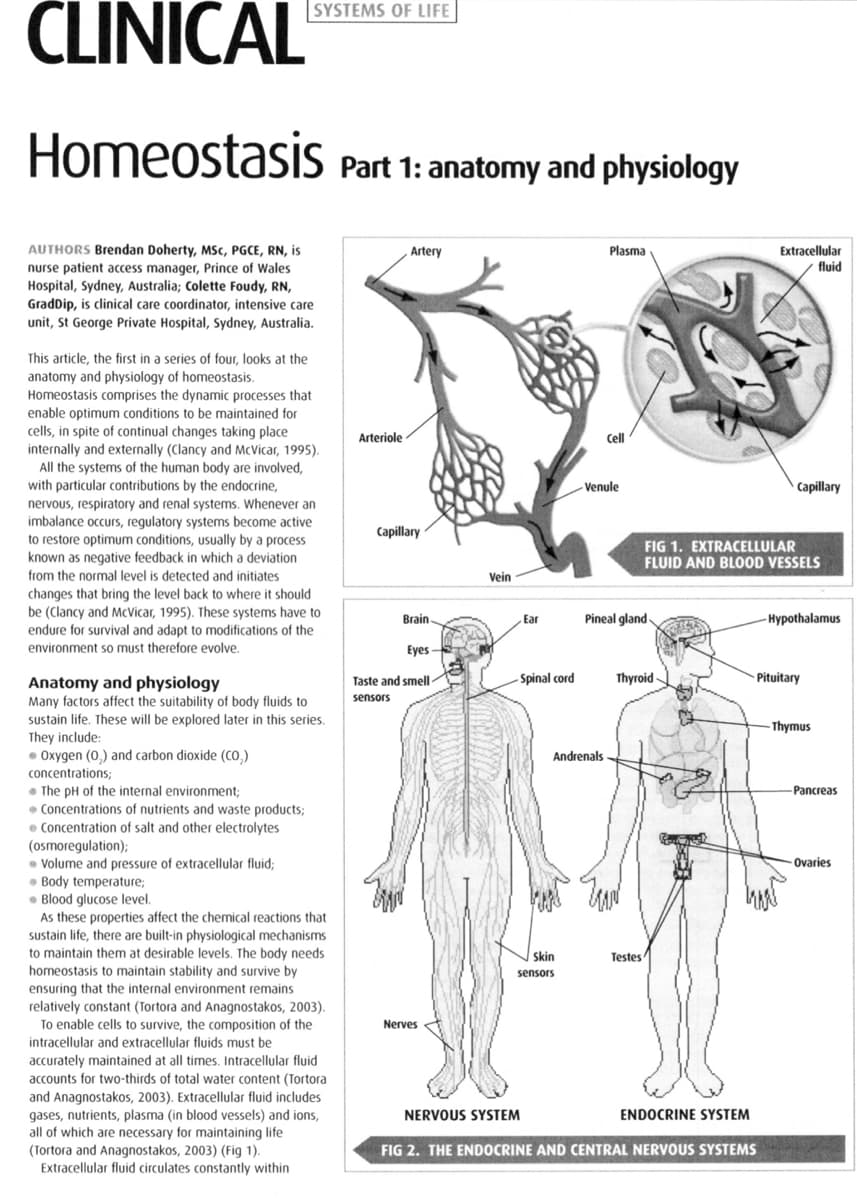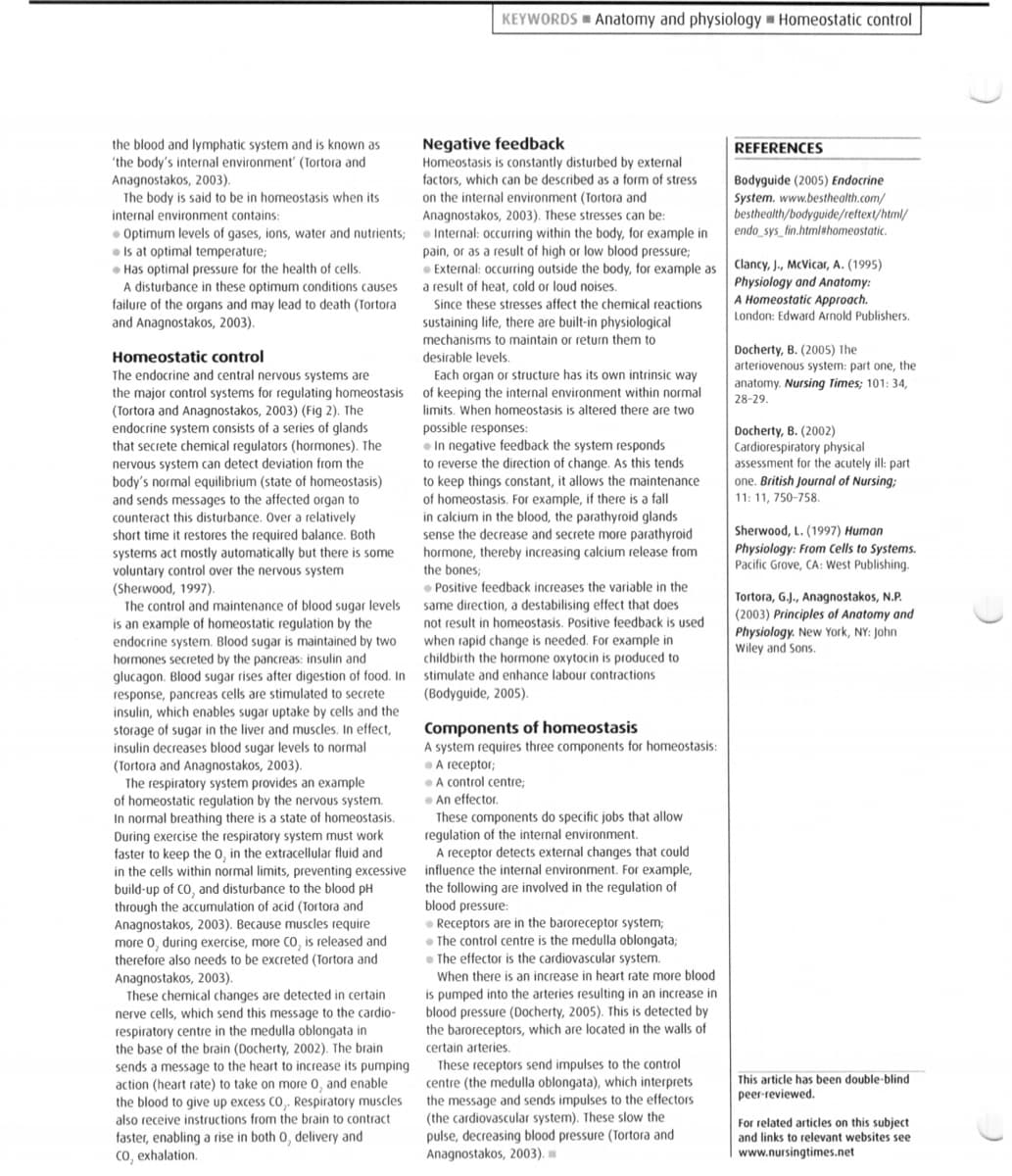Comprehensive Medical Assisting: Administrative and Clinical Competencies (MindTap Course List)
6th Edition
ISBN:9781305964792
Author:Wilburta Q. Lindh, Carol D. Tamparo, Barbara M. Dahl, Julie Morris, Cindy Correa
Publisher:Wilburta Q. Lindh, Carol D. Tamparo, Barbara M. Dahl, Julie Morris, Cindy Correa
Chapter5: The Therapeutic Approach To The Patient With A Life-threatening Illness
Section: Chapter Questions
Problem 2CR
Related questions
Question
What is the difference between positive and negative feedback? (Use the article attached)

Transcribed Image Text:CLINICAL
SYSTEMS OF LIFE
HomeostasiS Part 1: anatomy and physiology
AUTHORS Brendan Doherty, MSc, PGCE, RN, is
Extracellular
fluid
Artery
Plasma
nurse patient access manager, Prince of Wales
Hospital, Sydney, Australia; Colette Foudy, RN,
GradDip, is clinical care coordinator, intensive care
unit, St George Private Hospital, Sydney, Australia.
This article, the first in a series of four, looks at the
anatomy and physiology of homeostasis.
Homeostasis comprises the dynamic processes that
enable optimum conditions to be maintained for
cells, in spite of continual changes taking place
internally and externally (Clancy and McVicar, 1995).
Arteriole
Cell
All the systems of the human body are involved,
with particular contributions by the endocrine,
Venule
capillary
nervous, respiratory and renal systems. Whenever an
imbalance occurs, regulatory systems become active
to restore optimum conditions, usually by a process
known as negative feedback in which a deviation
from the normal level is detected and initiates
Capillary
FIG 1. EXTRACELLULAR
FLUID AND BLOOD VESSELS
Vein
changes that bring the level back to where it should
be (Clancy and McVicar, 1995). These systems have to
endure for survival and adapt to modifications of the
Brain
Ear
Pineal gland
-Hypothalamus
environment so must therefore evolve.
Eyes
Taste and smell -
Spinal cord
Thyroid-
- Pituitary
Anatomy and physiology
Many factors affect the suitability of body fluids to
sustain life. These will be explored later in this series.
They include:
• Oxygen (0,) and carbon dioxide (Co,)
sensors
- Thymus
Andrenals
concentrations;
• The pH of the internal environment;
• Concentrations of nutrients and waste products;
• Concentration of salt and other electrolytes
(osmoregulation);
• Volume and pressure of extracellular fluid;
• Body temperature;
• Blood glucose level.
As these properties affect the chemical reactions that
sustain life, there are built-in physiological mechanisms
to maintain them at desirable levels. The body needs
homeostasis to maintain stability and survive by
ensuring that the internal environment remains
relatively constant (Tortora and Anagnostakos, 2003).
To enable cells to survive, the composition of the
Pancreas
Ovaries
Skin
Testes
sensors
Nerves
intracellular and extracellular fluids must be
accurately maintained at all times. Intracellular fluid
accounts for two-thirds of total water content (Tortora
and Anagnostakos, 2003). Extracellular fluid includes
gases, nutrients, plasma (in blood vessels) and ions,
all of which are necessary for maintaining life
(Tortora and Anagnostakos, 2003) (Fig 1).
Extracellular fluid circulates constantly within
NERVOUS SYSTEM
ENDOCRINE SYSTEM
FIG 2. THE ENDOCRINE AND CENTRAL NERVOUS SYSTEMS

Transcribed Image Text:KEYWORDS Anatomy and physiology Homeostatic control
Negative feedback
Homeostasis is constantly disturbed by external
factors, which can be described as a form of stress
on the internal environment (Tortora and
Anagnostakos, 2003). These stresses can be:
• Internal: occurring within the body, for example in
pain, or as a result of high or low blood pressure;
• External: occurring outside the body, for example as
a result of heat, cold or loud noises.
the blood and lymphatic system and is known as
'the body's internal environment' (Tortora and
Anagnostakos, 2003).
The body is said to be in homeostasis when its
REFERENCES
Bodyguide (2005) Endocrine
System. www.besthealth.com/
bestheolth/bodyguide/reftext/html/
endo sys_fin.htmlshomeostatic.
internal environment contains:
• Optimum levels of gases, ions, water and nutrients;
• Is at optimal temperature;
• Has optimal pressure for the health of cells.
A disturbance in these optimum conditions causes
failure of the organs and may lead to death (Tortora
and Anagnostakos, 2003).
Clancy, J., McVicar, A. (1995)
Physiology and Anatomy:
A Homeostatic Approach.
Since these stresses affect the chemical reactions
London: Edward Arnold Publishers.
sustaining life, there are built-in physiological
mechanisms to maintain or return them to
Docherty, B. (2005) The
arteriovenous system: part one, the
anatomy. Nursing Times; 101: 34,
28-29.
Homeostatic control
The endocrine and central nervous systems are
the major control systems for regulating homeostasis
(Tortora and Anagnostakos, 2003) (Fig 2). The
endocrine system consists of a series of glands
that secrete chemical regulators (hormones). The
nervous system can detect deviation from the
body's normal equilibrium (state of homeostasis)
and sends messages to the affected organ to
counteract this disturbance. Over a relatively
short time it restores the required balance. Both
desirable levels.
Each organ or structure has its own intrinsic way
of keeping the internal environment within normal
limits. When homeostasis is altered there are two
possible responses:
• In negative feedback the system responds
to reverse the direction of change. As this tends
to keep things constant, it allows the maintenance
of homeostasis. For example, if there is a fall
in calcium in the blood, the parathyroid glands
sense the decrease and secrete more parathyroid
hormone, thereby increasing calcium release from
the bones;
• Positive feedback increases the variable in the
Docherty, B. (2002)
Cardiorespiratory physical
assessment for the acutely ill: part
one. British Journal of Nursing;
11: 11, 750-758.
systems act mostly automatically but there is some
voluntary control over the nervous system
Sherwood, L. (1997) Human
Physiology: From Cells to Systems.
Pacific Grove, CA: West Publishing.
(Sherwood, 1997).
The control and maintenance of blood sugar levels
is an example of homeostatic regulation by the
same direction, a destabilising effect that does
not result in homeostasis. Positive feedback is used
when rapid change is needed. For example in
childbirth the hormone oxytocin is produced to
Tortora, G.J., Anagnostakos, N.P.
(2003) Principles of Anatomy and
Physiology. New York, NY: John
Wiley and Sons.
endocrine system. Blood sugar is maintained by two
hormones secreted by the pancreas: insulin and
glucagon. Blood sugar rises after digestion of food. In stimulate and enhance labour contractions
response, pancreas cells are stimulated to secrete
insulin, which enables sugar uptake by cells and the
storage of sugar in the liver and muscles. In effect,
insulin decreases blood sugar levels to normal
(Tortora and Anagnostakos, 2003).
The respiratory system provides an example
of homeostatic regulation by the nervous system.
In normal breathing there is a state of homeostasis.
During exercise the respiratory system must work
faster to keep the 0, in the extracellular fluid and
in the cells within normal limits, preventing excessive
build-up of CO, and disturbance to the blood pH
through the accumulation of acid (Tortora and
Anagnostakos, 2003). Because muscles require
more 0, during exercise, more CO, is released and
therefore also needs to be excreted (Tortora and
Anagnostakos, 2003).
These chemical changes are detected in certain
nerve cells, which send this message to the cardio-
respiratory centre in the medulla oblongata in
the base of the brain (Docherty, 2002). The brain
sends a message to the heart to increase its pumping
action (heart rate) to take on more 0, and enable
the blood to give up excess CO,. Respiratory muscles
also receive instructions from the brain to contract
faster, enabling a rise in both 0, delivery and
Co, exhalation.
(Bodyguide, 2005).
Components of homeostasis
A system requires three components for homeostasis:
A receptor;
A control centre;
An effector.
These components do specific jobs that allow
regulation of the internal environment.
A receptor detects external changes that could
influence the internal environment. For example,
the following are involved in the regulation of
blood pressure:
• Receptors are in the baroreceptor system;
• The control centre is the medulla oblongata;
• The effector is the cardiovascular system.
When there is an increase in heart rate more blood
is pumped into the arteries resulting in an increase in
blood pressure (Docherty, 2005). This is detected by
the baroreceptors, which are located in the walls of
certain arteries.
These receptors send impulses to the control
centre (the medulla oblongata), which interprets
the message and sends impulses to the effectors
(the cardiovascular system). These slow the
pulse, decreasing blood pressure (Tortora and
Anagnostakos, 2003). m
This article has been double-blind
peer-reviewed.
For related articles on this subject
and links to relevant websites see
www.nursingtimes.net
Expert Solution
This question has been solved!
Explore an expertly crafted, step-by-step solution for a thorough understanding of key concepts.
This is a popular solution!
Trending now
This is a popular solution!
Step by step
Solved in 2 steps

Knowledge Booster
Learn more about
Need a deep-dive on the concept behind this application? Look no further. Learn more about this topic, biology and related others by exploring similar questions and additional content below.Recommended textbooks for you

Comprehensive Medical Assisting: Administrative a…
Nursing
ISBN:
9781305964792
Author:
Wilburta Q. Lindh, Carol D. Tamparo, Barbara M. Dahl, Julie Morris, Cindy Correa
Publisher:
Cengage Learning



Comprehensive Medical Assisting: Administrative a…
Nursing
ISBN:
9781305964792
Author:
Wilburta Q. Lindh, Carol D. Tamparo, Barbara M. Dahl, Julie Morris, Cindy Correa
Publisher:
Cengage Learning

